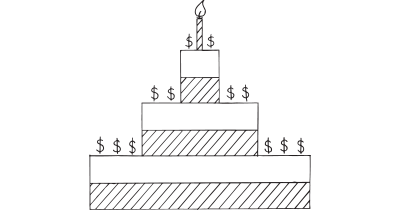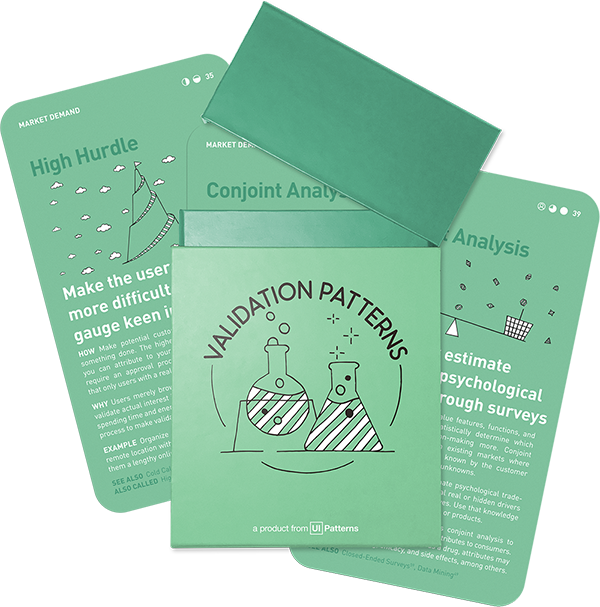Also called: Fundraising
See also: Collect Pre-orders, Crowdsourcing, Crowdsourcing
Difficulty: Intermediate
Evidence strength
Relevant metrics: Views, Items sold, Comments, Conversions
Validates: Viability, Desirability
How: Advertise your product idea to allow customers to back your project for product development or production at different investment levels, each providing different benefits in return. Choose an existing crowdfunding platform or brew your own, depending on your intended audience and its match with your product or cause.
Why: Gain market feedback quickly while building awareness and reputation. Create a forum for engaging highly interested early adopters and beta testers by publishing progress through creator updates. Hopefully you will receive feedback excitement in return.
This experiment is part of the Validation Patterns printed card deck
A collection of 60 product experiments that will validate your idea in a matter of days, not months. They are regularly used by product builders at companies like Google, Facebook, Dropbox, and Amazon.
Get your deck!Before the experiment
The first thing to do when planning any kind of test or experiment, is to figure out what you want to test. To make critical assumptions explicit, fill out an experiment sheet as you prepare your test. We created a sample sheet for you to get started. Download the Experiment Sheet.
What crowdfunding model should I choose?
There are several kinds of crowdfunding approaches. Before doing anything else, understand their differences to find which is the right for you.
- Rewards-based crowdfunding. In the reward-based crowdfunding model, backers typically contribute small amounts of money in exchange for some sort of reward. The reward does not necessarily have to be the item being produced, but it often is. Crowdfunding platforms like Kickstarter or IndieGogo are popular in this space.
- Donation-based crowdfunding. Donors generally donate small amounts of often and often, the reward is non-existant except goodwill and perhaps a tax-reduction. Even though there is no significant reward, campaigners often come up with smart and valuable digital rewards to boost donations. The primary platforms in this space are GoFundMe and CrowdRise although Indiegogo also has a donation/personal section.
- Equity-based crowdfunding. Investors invest money a get a (typically small) piece of equity of your company or project. Popular platforms include AngelList and Crowdfunder.
- Debt-based crowdfunding. Micro-loans with the expectation to get paid back the principal plus interest, although lesser known, makes up a large piece of the global crowdfunding industry. It is like a bank loan with interest, but instead of one bank, there are multiple lenders.
- Recurring crowdfunding. Patrons contribute a recurring amount of money – either on a specific time and period (for instance every week or month) or triggered by the creator making something new (for instance a song, a new album, etc.)
The reward-based crowdfunding model works especially well for testing your minimum viable product. Platforms like Kickstarter and Indiegogo can help as a chennel to put prototypes in the hands of target customers at a scale that is big enough to gather actionable feedback and small enough to be managable as an experiment.
After the experiment
To make sure you move forward, it is a good idea to systematically record your the insights you learned and what actions or decisions follow. We created a sample Learning Sheet, that will help you capture insights in the process of turning your product ideas successful. Download the Learning Sheet.
Popular tools
The tools below will help you with the Crowdfunding play.
-
Kickstarter
Popular reward-based crowdfunding platform
-
Indiegogo
Popular crowdfunding platform seeking to discover new products before they go mainstream
-
Crowdrise
Social crowdfunding for non-profits
-
GoFundMe
Crowdfunding platform aimed at personal campaigns for individuals.
-
AngelList
Equity based crowdfunding platform that connects investors and entrepreneurs.
-
Crowdfunder
Hotjar is an anlytics service that lets you track user activity, replay their actions, and add micro-surveys that ask about specific behavior.
Examples
Pebble Smartwatch
On May 24 2016, startup Pebble raised over $1 million in an hour on Kickstarter.com. The campaign ended up raising over $12 million. Pebble made a video, prepared pictures of the future product, wrote up text, and spread the word between friends and the media.
Valser water
Coca-Cola used crowdfunding for market validation with its campaign for Valser water on Indiegogo. This approach helped the company quickly gauge consumer interest and bring the product to market more rapidly. The campaign provided valuable insights, including direct feedback from consumers, which is particularly beneficial for brands that typically lack first-party customer data
Source: How Coca-Cola, Lego and Gillette tapped into the wisdom of crowds
Related plays
- The Difference Between Crowdfunding and Crowdsourcing by Clay Hebert
- Is Your Idea Right for Crowdfunding? by Clay Hebert
- Crowdfunding to test the Minimum Viable Product (MVP) by Jill

